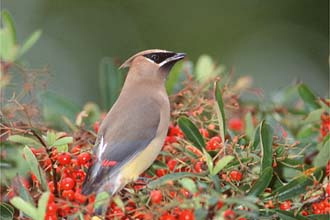
Cedar Waxwing on Pyracantha
Waxwings are Wild
Wild creatures must remain
free
Wild creatures must remain free
 Cedar Waxwing on Pyracantha |
Wild creatures must remain free |
Copyright (c) 2000, 2013 Douglas Dunn / Word Wizards communications -- all rights reserved
Birding resources in North San Diego
County, California
Waxwing Videos (Free)
Waxwings in San Diego County, California
References -- for further reading and research
Copyright (c) 2000, 2013 Douglas Dunn / Word Wizards communications -- all rights reserved
Waxwings are beautiful birds of mystery -- masked bandits raiding fruit from forests and orchards or snatching unsuspecting insects -- with unpredictable patterns of movement and migration and fascinating rituals of social interaction, gluttonous "drunken" revelry and tender, gentle food sharing. They are also creatures that need to be wild and free.
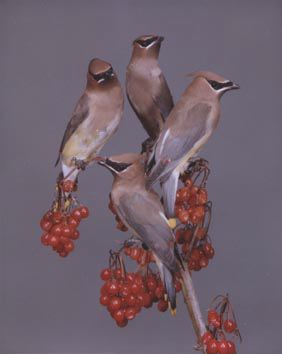 Cedar Waxwing foursome |
In North America there are only two species of waxwings: the Cedar Waxwing (scientific name: bombycilla cedrorum; Spanish: Ampelis Americano or Ampelis Chinito; French: Jaseur des cèdres or Jaseur d'Amerique) is the more common, but is found only in this continent while the Bohemian Waxwing (scientific name: bombycilla garrulus; Spanish: Ampelis Europeo; French: Jaseur boréal), more rare in this hemisphere, is common in the Northern latitudes throughout Europe and Asia, from the British Isles to Siberia. |
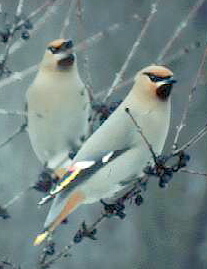 Pair of Bohemian Waxwings |
|
Appearance: smooth, silky plumage, with "bandit mask" and wax-like droplets on tips of secondary flight feathers. Waxwings are small birds, but not tiny. The Cedar Waxwing is between the size of a sparrow and a robin; the Bohemian Waxwing is somehwat larger and more grayish than the cinnamon-brown Cedar Waxwing; the Bohemian also has a pattern of black, yellow and white on its wings which the Cedar is lacking, and the undertail coverts of the Bohemian are rust colored while those of the Cedar are white. When viewed at a distance, Waxwings offer two distinct profiles: when flying and moving about they are sleek and lovely; right after feeding (gorging themselves) they have a more plump or squat appearance ... fat and contented. The waxwing head is adorned with a sleek crest; waxwings are the only brown crested birds. The crest lays flat or elevates to show contentment or fear/agitation. Males and females have a similar appearance and it is generally difficult to tell them apart by sight. |
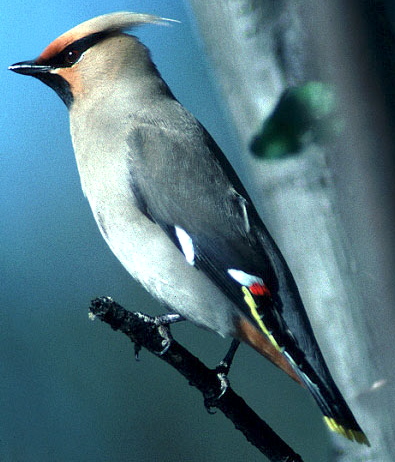 Bohemian Waxwing is slightly larger, more grayish, with black, white and yellow on wings and rust under tail |
|
While the Cedar and Bohemian are the only two waxwing species in North America, worldwide there is a third species, the Japanese Waxwing (bombycilla japonica), which lives only in Asia. In appearance, the Japanese Waxwing has some features in common with both the Cedar and Bohemain Waxwings. It has the bright colors and smaller size of the Cedar Waxwing, but bold wing patterns similar to (or even more striking than) those of the Bohemian Waxwing. It has the rust crisal and rust facial markings of the Bohemian, with the light-cream breast of the Cedar. The tail-tip can be either yellow or bright pink. A striking difference is that the Japanese Waxwing does not include the red waxy drops on the flight feathers that give the name to the species! |
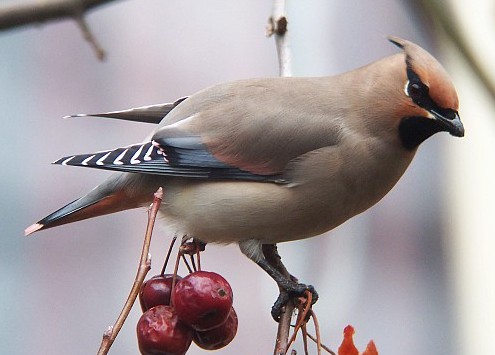 The Japanese Waxwing is perhaps the most colorful of the Waxwings, with features from both Cedar and Bohemian. It is found only in northeastern Asia, and not in North America. |
Gender differentiation: Males and females have a similar appearance and many observers find it difficult to tell them apart by sight. However, there is one clue that can be easily recognized for determining sex in Cedar Waxwings. The feathers of the chin, extending backward a little from beneath the black bill, are darker than the surrounding tawny-brown feathers. In males, this is a dark, shiny black; in females it is a much lighter shade of brown. This technique does not work for identifying gender in Bohemian Waxwings, whose entire throat is a dark black for both males and females.
Habitat: Preferred habitat is open woodland (such as that found in many parklands or at the edges of forests), with proximate access to running water and food sources. Examples of ideal sites would include parks, golf courses, landscaped commercial/industrial/apartment properties, college campuses, gardens and cemeteries that have berry plants used as ornamentals and ponds or creeks to supply water for bathing and drinking.
Identification: Watch for identifying "appearance"
features described above, but also for flock movement patterns.
Despite moving in large numbers, waxwings flocked in trees or
shrubs blend in with the foliage and may be difficult to spot.
Key to finding them is to locate likely habitats for the season,
and then listening for their distinctive call (sample can be found
at: http://birds.cornell.edu/BOW/CEDWAX/).
When surrounded by a large flock, the sound echoes gently from
all directions. Other keys are to watch for movements of the flock
in flight.
Waxwings can be observed in several flight patterns: when the
flock is perched in a tree or shrub, birds may be locally active
individually or in small groups, in a smooth, graceful, fluttering
flight movement, often hovering briefly, especially when engaging
in flycatching behavior. When the flock moves together to a new
area, the movement can either be in a shimmering, fluttering group
movement with frequent changes of direction (with all the birds
in unison, in a pattern that resembles the movement of flocks
of starlings), or a tight, fast formation as the birds glide very
quickly toward a specific destination, again in unison. Rarely
one might spot a small number of waxwings moving together without
the tight, synchronized harmony that is usually seen.
Migration: flock movement is in a nomadic, unpredictable migration within general annual trends: waxwings are opportunistic feeders who move following the food supply. As they roam areas, they may stay in one place that provides a supply of berries and flowing water for a few days or a few weeks, then after they have been seen every day in great quantities, all of a sudden they just seem to disappear without warning. Even while they are continuing to frequent a site over a period of days, within that time they still move among various sites throughout the day -- they may be seen at a particular time several times during the day in large numbers, small numbers, or not at all as the flock forages among several sites.
Diet: mostly fruits (85%-90%) and insects, especially insect pests. Fruits include primarily berries such as cherries, mulberries, elderberries, grapes, blackberries, blueberries and, during winter travels, toyon and pyracantha (firethorn). They also eat the fruits of date palms and the blossoms of various tree species. Heavy reliance on a predominantly fruit diet generates a strong thirst and these birds also require a ready water supply.
Except during the mating seasons, when they set up nesting pairs (though several pairs may be in relatively close proximity to each other), waxwings travel in large flocks. They are highly social birds.
While they are prodigious feeders, taking advantage of uncertain food supplies, their social structure leads to certain feeding rituals. One of the unusual traits that waxwings are well known for is their social feeding, in which birds will share food. Most commonly, this is done as a mating ritual in which one bird (usually the male) will bring an offering of food (such as a berry, insect or flower petal) to the other. The receiver will accept the gift, hop away to one side, then hop back and give the food back. They will exchange the food back and forth numerous times before one of them (usually the female) actually eats it. This is a ritual I have personally observed a number of times. More rarely reported in others' accounts, and which I have not personally observed, is the ritual of social feeding in which one bird will pluck a berry and, instead of swallowing it, pass it beak-to-beak to the next bird, who will do the same, down and back along a row of birds sitting on a branch or wire. Finally one bird will eat the fruit and they'll do it again, until eventually they just descend on the fruit source and strip it cleanor begin their more typical pattern of shuttling back and forth from a "staging area" to their food source.
Even this more common feeding ritual, more typical of their everyday behavior, reflects their social cooperation and sharing which is so different from other flock birds who may band together for their common interest in finding food or protection but will compete vigorously for the food they find. In contrast, waxwings will move about in flocks, and locate food sources where there is plenty of supply for the whole flock. Many times, they will settle into the upper branches of a tall tree near the food source, sort of as a staging area for their feeding operations. Then five or ten birds will shuttle down to the source of the berries, followed shortly by another five or ten birds, and so on, with the flock taking turns or rotating in and out of the food source sequentially and orderly instead of the chaotic competition so common to other bird species. A similar pattern of taking turns in groups is used for bathing when water sources are limited, such as to a bird bath or small puddle.
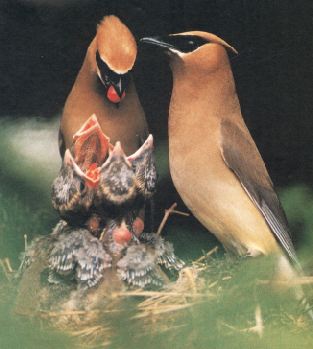 Photo credit: Monte Lewis |
They eat in voracious quantities -- gorging in gluttonous revelry. On occasion, they will eat fruit that is overripe and eat in such quantities that they will become intoxicated, as reported by numerous observers. The famous artist and naturalist, John James Audubon, would sometimes catch specimens of waxwings for his art by finding them so drunk that they became unable to fly, and just walking out and picking them up. Between their intricate rituals of social feeding and sharing and their tendency to "drink" to intoxicating excess, one could truly call these the "party animals" of the bird world. [An alternative theory of waxwing "drunkenness" is that they as they store berries in the crop, the load may press against the carotid arteries, resulting in impairment or loss of consciousness; however, studies reported by Mark Witmer for Birds of North America evaluated metabolic alcohol processing in waxwings and determined their vulnerability to alcohol intoxication. There is no information as to whether or not they experience hangovers.] Like many other flock birds such as parrots, parakeets, pigeons/doves, crows/jays and others, their affinity for social interactions renders them relatively tame birds and they can sometimes be coaxed to the hand, especially during the breeding season when they are attracted by such nesting materials as soft string or burlap or other materials that they might not otherwise be able to find. When nesting they do not seem to be especially frightened of humans approaching the nest and (unlike other species) will even continue to care for their offspring that have been handled by human hands. |
As fruit eaters, with supplies from orchards often lasting into the fall harvests, waxwings are able to breed later in the season than most birds, and will sometimes produce two broods during the summer.
Females primarily incubate the eggs while males bring food supplies but after eggs have hatched, both males and females take an active role in feeding and nurturing the young.
Baby Waxwings practice sharing rituals Photo (c) courtesy Ray Packard Stock Photos |
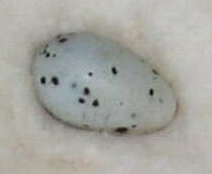 Cedar Waxwing egg |
When fall and winter approach and food supplies become thin (or out of season) they migrate in their unpredictable patterns out of the northern states and into most of the southwestern and southeastern states. (The Cedar Waxwing covers a wider range and in North America is more populous than the Bohemian Waxwing; however the Bohemian Waxwing is widespread throughout all of Europe and Asia; a third species, the Japanese Waxwing, is the most colorful of all the waxwings, and is found only in Japan.)
In my observations over the years in my home area of Southern California, where Waxwings are winter visitors only and do not breed, I have observed that as the birds arrive from November to January and move around in flocks, that males and females group separately. In small flocks of ten or fewer, the entire group will usually be either all males or all females. In larger flocks (more than 30, ranging up to hundreds) both genders will be present, but the males will be grouped together in small clusters separate from females similarly but separately grouped.
Waxwings also require a steady water supply to quench the thirst that builds up from eating so much high-sugar fruit, and they often roost near water supplies. They also seem to enjoy splashing and bathing in shallow ponds and streams and those wishing to attract waxwings would do well to provide a birdbath or shallow waterfall along with food supplies of berries.
I remember well the moment when I was first struck with the beauty and unique behavioral of waxwings that made them so attractive to me. As a child, from about age 8, I had been fascinated with birds. I often went to the local library to read about birds, and had several bird books (that I still own today, more than 50 years later). I had seen waxwings on the pages of these books, including a 1961 update of Roger Tory Peterson's famous classic. But one day, in the library, I pulled a book off the shelf. Sadly, the title and author are lost to history and inadequate human memory. It highlighted ten species the author had found notable. I turned each page through various species, and when I turned to the one on the Cedar Waxwing, a stunningly beautiful photograph introduced a lengthy article highlighting some of the peculiar social and irregular behaviors of this unpredictable masked bandit. At that time, I had never seen a waxwing in person, and the first time I did, it only reinforced the beauty and specialness of this popular favorite.
The first time I experienced an intimate personal encounter with waxwings: One February morning in 1969, when I was a college student (back in February of 1969) I had a job on campus working as a groundskeeper for the dorms. Early one morning as I was out picking up trash, I saw the movement of a tiny brownish creature flopping about in a nearby bush. I could quickly see that it was a bird, and then ... a waxwing! Working in the rocky mountains, where waxwings were not common winter visitors, it was a rare treat. But I had read enough about waxwings to know that they are not solitary birds; if one is around, especially in winter when they are not in nesting pairs, there should be a lot more! I also knew what foods would be appropriate and made sure I had plenty of fresh fruits to serve.
I also noticed that, once this little fella realized I had spotted it (male and females waxwings have similar appearance so hard to tell which it was), it began flapping around trying to get away. But it did not fly and did not get very far. I could quickly see that it had an injured wing, so I scooped it up protectively and took it to my car and, living nearby, drove home and set it loose in my room (I had an old parakeet cage, but didn't want to confine a wild bird accustomed to freedom in such a small space).
I hurried back to work and quickly came across a flock of waxwings lined up along the branches of one of the trees near the dorms. So I knew that this injured bird I had found had, in fact, traveled with its flock but had become injured and separated from its companions. I also knew that since waxwings move quickly and unpredictably, following uncertain food supplies (especially in winter), that I would have to monitor the flock and make sure to get this little fella back to its social environment before they moved on and left it behind.
Each day as I worked, I monitored the flock, while back at my room I nursed my little visitor back to health. This little bird was very tame, as is also reported of waxwings by others, but I sensed a feeling of loneliness as it missed its companions.
Within a couple of days, I found another member of the large flock flapping helplessly within the bushes and brought it home to share a room in the bird hospital with its buddy. The first bird was already improving physically, and this highly social creature seemed to perk up with the arrival of a companion. Both birds continued to be tame and friendly and did not make any effort to avoid me once they realized I was caring for them, bringing them food and would do them no harm.
Each day as I worked I continued to monitor the flock, concerned that they might move on before I could return healthy companions. I knew that they would not stay long, but could not predict when they would move on. Meanwhile, the two birds in my room continued to improve and gain strength, and were soon flying around the room, though still showing no particular fear of me nor any effort to avoid me.
Although the birds were tame, I never considered keeping them as pets. I knew they were wild and free and had lived their entire lives free to wander open spaces with their flock. It was always my intent to repatriate them to their own natural community, but my biggest concern was that the flock would move on before they were ready or that I might set them free before they were strong enough to care for themselves.
At the earliest possible time, when I felt that they might not be fully up to 100% but were likely well enough to be joined to their flock, I once again put them in my car and drove around to where I found the flock. One by one, I took the birds in my hand and tossed them toward their flock. They fluttered and flew up into the branches where they were welcomed by their friends. While their flight was not as confident as I might have liked, I felt comfortable that they were well enough to join their peers and that they would continue to heal faster in the social bonds they were most comfortable with.
A few days later, the flock moved on and my little friends were gone.
Since that time, I have enjoyed hundreds of sightings of wild waxwings.
| A more recent encounter: On a Saturday morning, March 9, 2013, I was sitting in my upstairs home office, overlooking a two-acre garden and pond on our property, when I observed a flock of Cedar Waxwings swooping down from above my window into the basin below. I rushed downstairs, stopping to grab a pair of binoculars, and as I rushed out through onto our rear patio facing the basin, I saw one Cedar Waxwing on our patio, near our pyracantha bushes, trying to get through the glass barrier. As frequently described in waxwing lore, she appeared to have consumed a few too many overripe pyracantha berries and was a bit tipsy. I easily reached down and picked her up, as she offered no resistance, which was, again, a sign that she may have been temporarily impaired. I brought her inside, let her sit awhile on a curtain rod in our family room, and after a few minutes, again reached for her, picked her up, took her back out to the patio, and let her fly freely to join the rest of her flock. |
Female Cedar Waxwing
perched on curtain rod in our family room March 9, 2012 |
These pictures were taken through the window, from inside our house, on February 18, 2015.
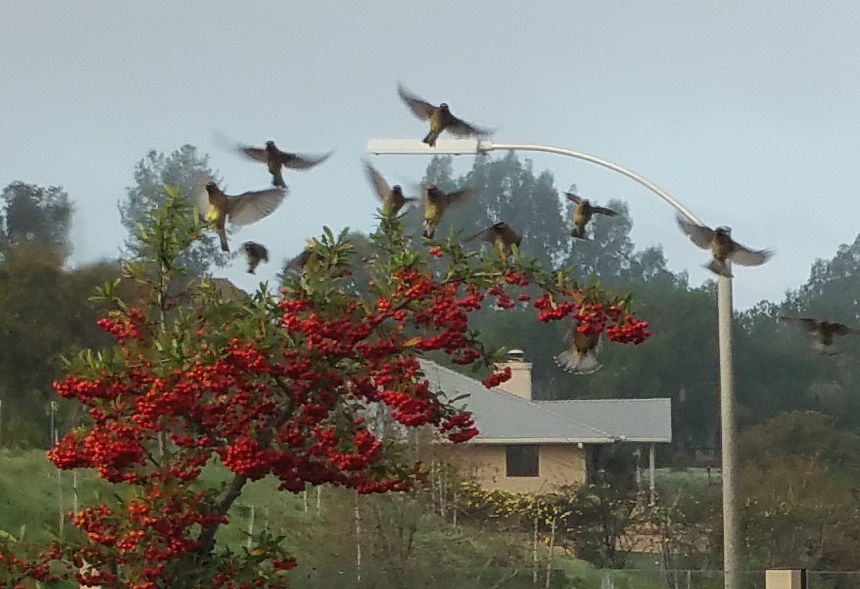 |
|
Birds are not humans, and it is a mistake to try and make them represent human values. But in a purely symbolic manner, we can metaphorically use some of the waxwing traits to demonstrate certain human ideals:
Social harmony and sharing: Waxwings move and behave in large flocks, and maintain complex social rituals such as their ceremonious berry-passing and their smooth, graceful "synchronized" flight formations -- some writers note that they at times they even appear to face in the same direction. These highly social creatures seem to bring an easy gracefulness to their complex social structures, and interact with each other gently and in peaceful harmony, without the displays of dominance and bullying that often characterize large social systems. While the young of many bird species squabble competitively over incoming food brought by parents, even fledgling waxwings begin "practicing" their unusual sharing rituals before they have even fledged.
Gender equality: In many bird species, males and females are highly differentiated. Males may display brighter and more colorful plumage and females may be physically larger in size. Males may also play a dominant role in the "pecking order" (literally -- avian hierarchies is where that term comes from) while females play the dominant role in nurturing the young. In waxwings it is different. Males and females are extremely similar in size and appearance. Despite large and complex social structures, there are not reports of dominance by specific individuals. And both males and females share in feeding and nurturing their young to a degree rare among bird species.
Harmony with nature: The main component of the waxwing diet is fruits. As berries are devoured, the fruit is digested but the seeds are not. As the waxwings fly around, they spread seeds to other areas of favored habitats (the ones they move among), and thus assist in plant reproduction (unlike seed-eaters who actually digest and thus destroy the seeds). They do not take from the environment without giving back far more than what they take. The secondary component of their diet is insects, and among those most targeted are those which are harmful to plants.
Partying: Lest anyone think these birds too saintly, as their dainty rituals of food sharing give way to gluttonous feasting and drunken bacchanals from consuming overripe fruit, we see that these birds are not only social and harmonious, but also gregarious party-goers! It makes us wonder if any of the researchers have made any effort to determine if waxwings enjoy this drunken revelry and if they suffer from morning-after hangovers! Their mysterious and unpredictable comings and goings as they move in irregular seasonal migrations as well as their frequent wanderings throughout the day make them all the more intriguing.
|
Cedar Waxwing dining on juniper cedar that gives this beautiful species its name. |
 |
San Diego Bird List: online discussion group for San
Diego County birders:
http://www.egroups.com/community/SDBIRDS.
Buena Vista Audubon Society -- 2202 South Coast Highway
(P.O. Box 480), Oceanside, California 92049. Phone: 760/439-BIRD
(2473).
Local chapter of the national Audubon Society for Oceanside and
Carlsbad (North County Coastal). Premises includes excellent visitors
center (no admission charge, but donatins gratefully accepted)
with extensive collection of taxidermy created from many species
of local birds and other wildlife.
Website: http://www.audubon.org/chapter/ca/buenavista.
Palomar Audubon Society -- P.O. Box 2483, Escondido,
California 92033. Phone: 858/487-4831.
Local chapter of the national Audubon Society for Escondido (North
County Inland).
Website: http://palomaraudubonsociety.homestead.com/index.html.
The Birdwatcher -- 2775 "B" Street, P.O. Box
388, Julian. Phone: 760/765-1817. http://www.the-birdwatcher.com/
This is a large, lovely shop filled with excellent resources for
birders or those who wish to attract birds to their yards, including
books, maps, supplies, knick-knacks, feeders and feed, and just
about anything else you can think of. A birder's dream come true.
Wild Birds Unlimited -- 2624 El Camino real, Carlsbad.
Phone: 760/720-1906. http://stores.wbu.com/carlsbad.
Attractive shop with feeders, bird seed, books and garden supplies
for those wishing to attract wild birds to their yards.
Wild Bird Center -- 1283 Encinitas Blvd., Encinitas
(Henry's/McDonald's Shopping Center). Phone: 760/334-6001.
Attractive shop with feeders, bird seed, books, birding equipment
and garden supplies for those wishing to attract wild birds to
their yards.
Free Video 1 -- Waxwings feasting
on berries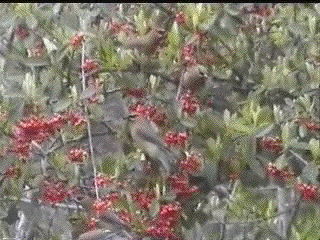 Video footage by Douglas Dunn Click here or on picture to view or download a free (recently taken) 20-second video (1.1MB) of waxwings in a frenzy of feeding on berries. |
Free Video 2 -- Waxwings splashing
in water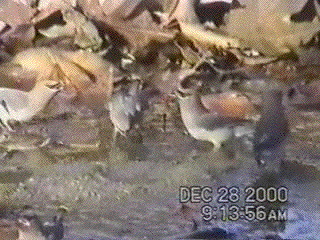 Video footage by Douglas Dunn and Thelma Mantos Dunn Click here or on picture to view or download a free 15-second video (1.5MB) of waxwings drinking, splashing and frolicking in a creek. |
[Both of these videos require version 3 or higher of QuickTime plug-in for Mac or Windows -- can be downloaded free at: http://www.apple.com/quicktime/download/index.html]
Cedar Waxwings are most common in the Northeast United States, ranging from Minnesota to Maine, where they are year-round residents in substantial quantities, as well as in Washington, Oregon and Idaho. Bohemian Waxwings are most common in the Rocky Mountain states of Idaho, Montana and Wyoming, with some wanderings into Utah; they are also numerous throughout western Canada. As the weather turns cold in fall and berries go out of season, with increased competition for limited food supplies, many Cedar Waxwings move south. Where I live, in Oceanside (a community in the North part of San Diego County), Cedar Waxwings are not present during the summer months and are not known to breed in this area. In winter and spring, however, they can be seen around the county in habitats that provide an attractive environment of open woodland with access to water and winter-berrying plants such as pyracantha, toyon and cotoneaster. Ideal sites would include parks, golf courses, landscaped commercial/industrial/apartment properties, college campuses, gardens and cemeteries that have berry plants used as ornamentals and ponds or creeks to supply water for bathing and drinking. Bohemian Waxwings have been sighted in this area only with extreme rarity, but Cedar Waxwings can often be seen in San Diego County from October through May in appropriate habitat environments.
Waxwings are contantly on the move, visiting a variety of sites each day, so even when they are regularly visiting an active site, one still might not see the birds at a specific site depending on whether or not the observer happens to be there at the same time the flock is present.
Some recommended sites for
viewing Cedar Waxwings in San Diego County:
It should be remembered that even at suggested sites where waxwings
are frequent visitors, and even in an irruption year, Cedar Waxwing
movements throughout the day are highly variable. At one time
of the morning there may be hundreds of birds, an hour later only
10-20, and two hours after that none at all, with hundreds more
showing up again later in the afternoon; the next day the times
they are at the site may be completely different. Or the waxwings
may have been there last month and will return again next month,
but might not be there at all for several days in a row. In looking
for waxwings at these sites, the key to finding them is to check
at various times of day and keep returning throughout the season.
Also it is important to listen for their distinct high-pitched
call or the movement of a flock in their distinct tight-formation
flight; once they settle into the trees they often hide among
the leaves and, despite their various colors and large numbers,
they may not be immediately obvious. Here are some of my recommendations
for where to look for Cedar Waxwings from October through May
... as I live in the North part of the County, my suggestions
naturally are weighted in that direction.
Kit Carson Park, Escondido
Cedar Waxwings are found throughout the north picnic area across
from the elementary school, often moving among the sycamores,
palms and other trees, and frequently splashing, drinking and
bathing in the creek. They may be in various areas of the picnic
area; when they are present in large numbers they may be in numerous
parts of the picnic area at the same time. This is one of the
most consistenly reliable sites for finding waxwings, but if you
come when they happen to be away, keep checking back.
Guajome County Park, Oceanside
Cedar Waxwings can be found in all areas of the part where there
are trees, and especially in the areas where there are large stands
of pyracantha or toyon. Some of the best areas are in the upper
campground area, anywhere from the camping restrooms to the upper
parking lot to the wedding gazebo, but especially in the area
at the north side of the campground where there are numerous pyracantha
and toyon plants. Waxwings also make occasional appearances in
the south picnic area, where the pyracantha and toyon plants are
located near the parking lot entrance; also can be found where
the creek runs along Santa Fe Rd.
Rancho Del Oro Community Park, Oceanside
This very small neighborhood park is mostly a grassy playing field
next to an elementary school, however along the west edge of the
park facing College Avenue and the south edge of the park along
Empresa Avenue are extensive spreads of cotoneaster on both sides
of the street, with intermittent trees where Cedar Waxwings gather,
often in very large numbers. Also, numerous sites in the surrounding
residential neighborhood may also have pyracantha, toyon and cotoneaster
that attracts the waxwings.
Brengle Terrace Park, Vista
This park has several pyracantha plants, and numerous stands of
toyon in various areas of the park, but especially in the creek
bed along the south end of the park. Cedar Waxwings may be found
in any of these areas, but especially along the creek between
the parking lot and the south side of the park.
Stagecoach Park, Carlsbad
This small neighborhood park in southeast Carlsbad has a shallow
creek, open trees and sits across the street from a large patch
of many cotoneaster plants. Cedar Waxwings can be frequent visitors,
often in very large numbers.
Oak Hill Memorial Park, Escondido
This cemetery has water and pyracantha and lots of open trees,
and Cedar Waxwings may be found in any area of the cemetery. The
surrounding neighborhood, extending west from the cemetery to
Orange Glen High School, also has many ornamental plants and date
palms and if you don't find the waxwings in the cemetery, you
may be able to find them nearby.
El Camino Cemetery, Sorrento Mesa, San Diego
Near the morturary and gift shop is a large field with many cedar
(juniper) plants which are very attractive to waxwings. There
is also a creek running alongside the cemetery and other decorative
fountains and water sources.
Mast Park, Santee
Cedar Waxwings may show up in very large numbers right near the
parking lot entrance, where there are large stands of cotoneaster
and toyon plants and a creek for them, as well as date palms and
numerous tall eucalyptus trees. This site has all the things waxwings
want and it has not escaped their attention.
Lindo Lake County Park, Lakeside
Many reports of large Cedar Waxwing flocks, especially around
the shallow stream at the far east side of the park that feeds
into the lake.
Julian Historic District
This small historic rustic mountain village has several sites
that attract waxwings, all within easy walking distance. Two of
the best are the cemetery and the landscaping of Orchard Hill
Country in with its generous growths of pyracantha, toyon and
misteltoe.
Palomar Mountain State Park
Various areas of this mountain park have flowing water and growths
of toyon that are attractive to waxwings.
Greenwood Cemetery, San Diego
Numerous reports of Cedar Waxwings in this cemetery.
Witmer, Mark C., Mountjoy, D. James, and Elliot, Lang. "Cedar Waxwing (Bombycilla Cedrorum)." in The Birds of North America, Number 309 (Alan Poole and Frank Gill, editors.) The Academy of Natural Sciences, Philadelphia, PA, and The American Ornithologists' Union, Washington, D.C. 1997.
Tyler, W.M. "Bombycilla Cedrorum: Cedar Waxwing" in Life Histories of North American Wagtails, Shrikes, Vireos and Their Allies. (Arthur Cleveland Bent, editor.) New York: Dover Publications: 1965 (Unedited reprint of: U.S. Government Printing Office: Smithsonian Institution United States National Museaum, Bulletin 197: 1950). pp.79-102
Bent, Arthur Cleveland, editor. "Bombycilla Garrulus: Bohemian Waxwing" in Life Histories of North American Wagtails, Shrikes, Vireos and Their Allies. New York: Dover Publications: 1965 (Unedited reprint of: U.S. Government Printing Office: Smithsonian Institution United States National Museaum, Bulletin 197: 1950). pp.62-79.
Stokes, Donald & Lillian. Guide to Bird Behavior, Volume 2. New York: Little, Brown &Company. 1983. (Cedar Waxwing, pp. 177-188)
Sibley, David Allen. National Audubon Society: The Sibley Guide to Birds. New York: Alfred A. Knopf. 2000. (Waxwings: pp. 423.)
Sibley, David, et. al, editors. National Audubon Society: The Sibley Guide to Bird Life & Behavior. New York: Alfred A. Knopf. 2001. (Waxwings: pp. 485-487; waxwing article by Mark Witmer.)
Martin, Alfred G. Hand-Taming Wild Birds at the Feeder. Brattleboro, VT: Alan C. Hood & Company. 1963. (Waxwings: pp 113-117)
Leister, Mary. "Cedar Waxwings: Unpredictable Birds." BirdWatcher's Digest. November/December 1991 (Vol 14, No. 2). pp. 50-55.
Iliff, Marshall J. "Identify Yourself: Waxwings -- Cedar versus Bohemian." BirdWatcher's Digest. October 2001 (Vol 24, No. 1). pp. 38-42.
Copyright (c) 2000, 2002 Douglas Dunn / Word Wizards communications
Links to other pages about waxwings:
http://web2.si.edu/smbc/bom/cewa.htm
-- Smithsonian waxwing page. Excellent info.
http://www.ronausting.com/cedar.htm
-- Great pictures, info and sounds of cedar waxwings.
http://birds.cornell.edu/BOW/CEDWAX/
-- Cornell University -- great info and sound file from one of
the world's premier ornithology institutions
http://www.mbr-pwrc.usgs.gov/id/framlst/Printversion/fs6190.html
-- United States Geological Survey general info on cedar waxwings
http://www.mbr-pwrc.usgs.gov/bbs/htm96/map617/ra6190.html
-- USGS summer (breeding) map for cedar waxwings
http://www.mbr-pwrc.usgs.gov/bbs/htm96/cbc622/ra6190.html
-- USGS winter distribution map for cedar waxwings
Link to Doug's Scrub Jay page: http://www.wordwiz72.com/bbird.html
Doug's Personal bird lover's web page:
Bird Whisperer or Bird Brain? Doug's life time love affair with birds is chronicled with picturers of interactions with both wild and domesticated birds, from childhood through adulthood.
New birding tool available: I have discovered, bought and downloaded some excellent - amazing, really - new tools to enhance my birding experience! As the happy owner of the Apple iPhone, I was pleased to learn that a complete field guide was available for downloading from iTunes to my iPhone!
It was iBird Plus for the iPhone, which I downloaded last December (and subsequently received TWO FREE UPGRADES!)
More recently, a more advanced edition has been released, iBird PRO for the iPhone. I have since downloaded and installed iBird PRO and it is amazing.
In addition to numerous pictures, maps and information for each bird, there are excellent search features to identify birds within seconds, and one of my favorite features in the actual bird sounds! No more trying to explain a sound to a novice birder, or looking at a description in the field guide text trying to figure out what fzreeep really sounds like!
By the way, I have no connection to the developer (Mitch Waite Group) other than being a very satisfied customer.
More information at: http://www.ibirdexplorer.com/product_finder.html.
We welcome FEEDBACK! Send e-mail feedback to: feedback.
Please note, be sure to BEGIN
the TITLE of your e-mail reply with the word "feedback"
to avoid having your e-mail deleted unread with all the other
junk e-mail that is mass deleted.
+More Articles:
Check out additional articles
by Douglas Dunn now available as FREE DOWNLOADS -- with additional
articles being added regularly, each one an adaptation of those
that have been published in mainstream newspapers and magazines
[more articles].
Books by Douglas
Dunn (click on book titles for descriptions of books and ordering
information):
--Dazhan.
--Extro-Dynamics.
Books written by Douglas Dunn may
also be ordered online through Barnes
and Noble, Borders.com
and/or Amazon.com.Also available
through other retail bookstores (if not in stock may be "special
ordered").
General Information about Waxwings
Birding resources in North San Diego County,
California
Waxwing Videos (Free)
Waxwings in San Diego County, California
References -- for further reading and research
Return to Word Wizards home page